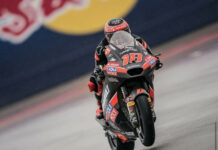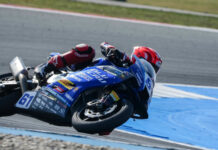The Brno Circuit is one of the most famous venues in World Championship racing that made the successful transition from the original road circuit to a permanent circuit, that has hosted the Championship since 1987, apart from one year in 1992. In spite of the number of curves and esses, which would lead one to think that this was a slow circuit, Brno is the sixth fastest in the World Championship with an average speed of 163.7 Km /h. The winding nature of the circuit is balanced by the great width of the track. The distance of 15 metres from one side of the track to the other allows the riders to take a racing line which makes the corners more open than they actually are. In addition there is relative parity between left and right-handed corners, six and eight respectively, so the tyres to be used are manufactured symmetrically and perform evenly throughout the lap. A crucial aspect to racing at this circuit, with eight esses around the track, is setting the suspension and chassis so that the bike is light and nimble. To enable this, it is important to set the bike up with as lower centre of gravity as possible, and with steering settings with short play to change direction quickly. Furthermore, since there are no excessively fast corners it is not necessary to find a big degree of stability in the front end of the bike. Suspension settings are not a particular problem since there are no real bumps on the track surface. Given the many esses, five of the eight of which are practically fast chicanes, stiff springs are used to withstand the forces that the bike is put under in these changes of direction. In the front suspension, we must pay particular attention to corner number ten as it comes after a sharp descent of five per cent and will be the point where there is most movement in the front. This corner is at the lowest part of the circuit. The engine settings are critical at this circuit. On the one hand the engine must give a smooth power delivery from 0% to 15% throttle. The corners are very long and the throttle is opened early on in the corner with the bike leaning, so the smoothness of the delivery is crucial to ensure a high speed on the following straight. However, on the other hand, this smooth delivery must not prejudice maximum power delivery since the sharp climbs (there is nearly one kilometre of continued ascent with an inclination of seven and a half per cent) mean that the engine must deliver full power to achieve high speeds during this climb. In normal circumstances the gearbox uses five gears where the first is only used for the race start. All other gears are used and must be set so that the engine revolutions are situated in the maximum power delivery zone. We must pay special attention to the second gear since, with the exception of the first and last corners which are taken in third gear, all other corners are taken in second. The importance of the second gear is underlined by the fact that 60% of the lap is taken in this gear. Since this is a balanced circuit, with the same number of left and right-sided corners, the tyres used are symmetrical and do not tend to cause too many problems. Only in years when it has been excessively hot have there been problems with the temperature in the rear, and on certain occasions, in corners like number one where there is a lot of bike lean, has chattering arisen.
Camel Honda’s Set-up Report For The Brno Circuit
Camel Honda’s Set-up Report For The Brno Circuit
© 2005, Roadracing World Publishing, Inc.






